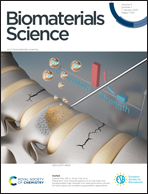Ultra-small NIR J-aggregates of BODIPY for potent phototheranostics†
Abstract
Cancer phototheranostics that combines diagnosis with phototherapy has emerged as a new mode of precise treatment. Nevertheless, taking highly effective phototheranostics into consideration, it is still a tremendous challenge to design multifunctional photothermal agents (PTAs) that combine the features of intensive near-infrared (NIR) absorption/emission, high photothermal conversion efficiency (PCE) and preferable tumor accumulation. Herein, seeking a convenient method to facilitate absorption red-shift, promote the accumulation of drugs in tumors and heighten the PCE appears to be particularly important for cancer theranostics. In this work, heavy-atom-free boron dipyrromethene (BODIPY) was assembled with F127 to fabricate ultra-small J-aggregated nanoparticles (named as BNPs). Compared to free BODIPY, BNPs exhibited 63 nm redshifted absorption, deep-tissue fluorescence imaging, enhanced cellular uptake, preferable tumor accumulation, elevated PCE, excellent photothermal stability and water dispersibility. In vivo experiments demonstrated that BNPs could behave as high-performance tumor fluorescent imaging probes and antitumor PTAs to conduct NIR imaging-guided PTT. This work offers a novel J-aggregated framework on developing robust diagnostic and therapeutic agents.



 Please wait while we load your content...
Please wait while we load your content...